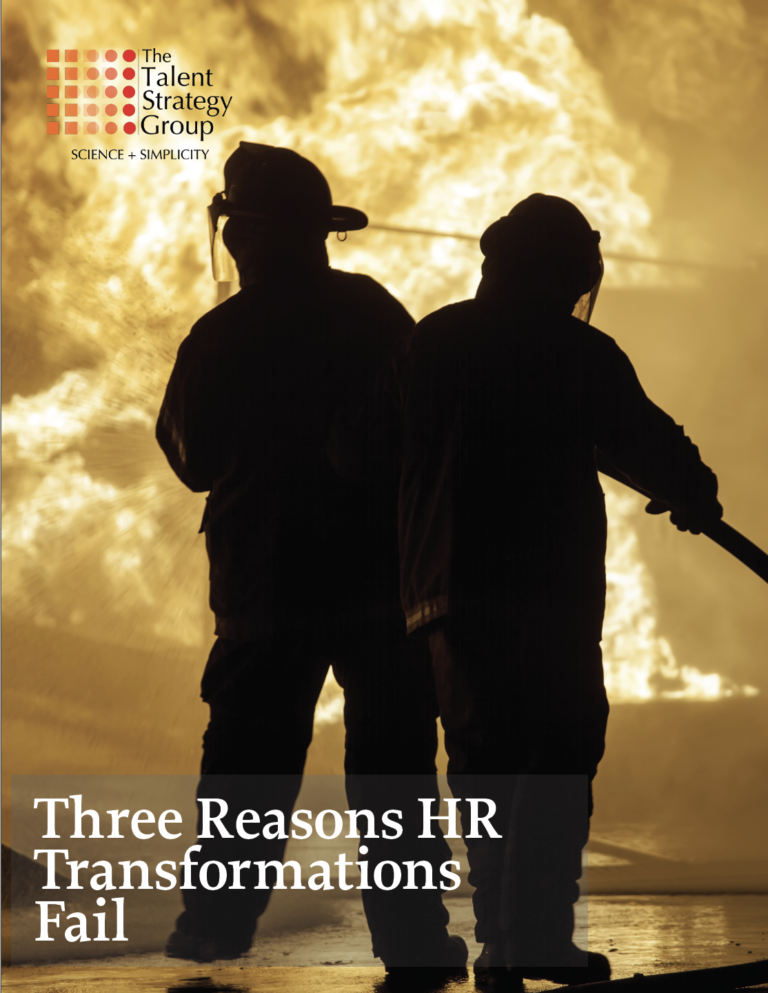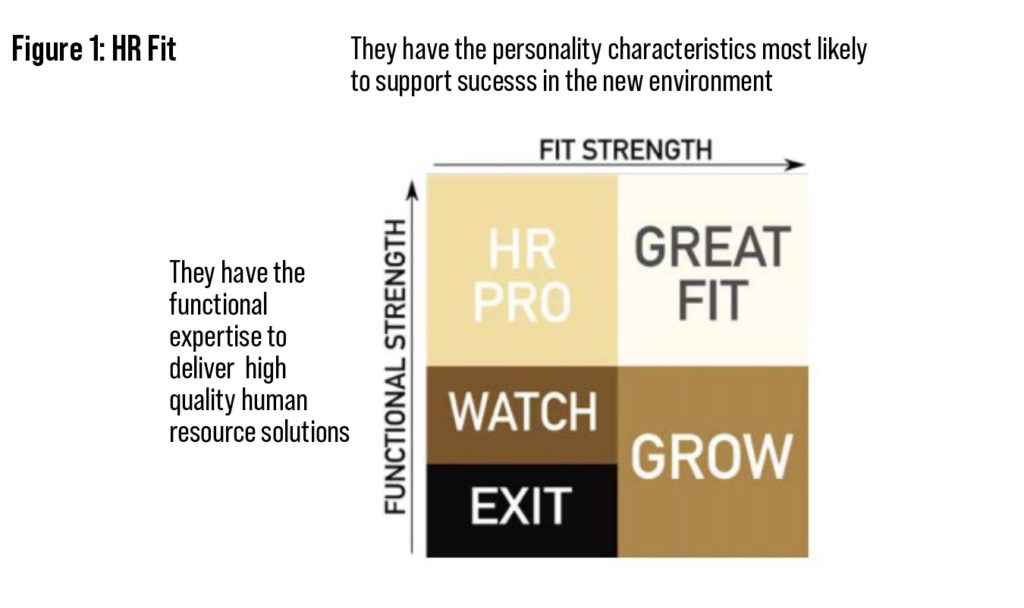Three Reasons HR Transformations Fail (and how to make sure yours doesn’t)

If you’re not in one or finishing one, you’re likely planning one. More than 80% of organizations say they’ve just completed or will soon start to transform their HR organization. Whether it’s driven by a technology upgrade, cost reductions or the desire to improve HR service quality, we find a common reaction at the end of transformation is . . . disappointment. Disappointment with how long it took (or is still taking), the “stickiness” of the outcome and the quality of the HR team when it’s done.
Our experience shows that it’s not the usual suspects – troublesome technology implementations, challenging budgets, etc. – that undermine the success of HR transformations. The real culprits are both softer and far more controllable. That’s good news because it means that you can overcome these obstacles and ensure a faster, more effective transformation.
The three areas where Chief Human Resource Officers should focus their attention are:
1. Clarify the Vision
There’s a classic change model that beautifully simplifies the essence of transformation – Unfreeze, Change, Refreeze (1). In our experience, this simple, powerful approach highlights what’s missing in most HR transformations.
Many HR organizations muscle through their redesign or transformation process without the proper preparation (unfreeze) or follow through (freeze) to ensure engagement during the process and real improvement after.
Unfreeze: The reasons given for HR transformation are often either vague or technology-based. Our view is that you shouldn’t transform HR because you’ve bought new technology. You should buy new technology to support how you want HR to be transformed.
This means the vision’s starting point must be a clear picture of HR’s future and the path to get there, including crisp statements describing:
- The outcomes that HR needs to deliver
- The changes we’ll go through to get there
- Why this is an exciting journey for you to join
- Why everyone might not make the journey
That vision should be your true north during the transformation – it should guide decisions, provoke urgency and, hopefully, inspire. And, while it may seem a little awkward, that last bullet is a critical one to emphasize.
If the new organization requires new capabilities, not everyone might be able to demonstrate those capabilities, so some might not make the journey. Be transparent about your process (to our recommendations above) and honest about the range of outcomes.
Refreeze: After the hard work of technically transforming HR, too few companies ensure its success by locking-in or “refreezing” the performance and behaviors most critical to the new model.
“Refreezing” is an incomplete term to describe this phase because success requires both refreezing the new state and keeping it frozen. What works to reinforce behavior change in any other setting works for refreezing as well.
We’ve seen all the following yield good results:
- Define new HR rules of engagement: The transformed environment may require HR business partners and COE specialists to interact in different ways, or for either group to interact with clients in different ways. This may be a good tine to redefine your entire HR operating model.
- Measure and report on vision execution: Identify the three metrics that best indicate if the transformed organization is performing as designed. Measure them at least every six months and make the HR leadership team jointly accountable (ideally through compensation) for their success.
- Celebrate and reinforce: As with any behavior change, reinforce through public recognition and reward individuals or groups who exemplify the skills and behaviors you want in the new environment.
2. Increase Talent Quality
There’s a lovely myth we hear from companies in the planning stages of HR transformation that sounds like this: “We have smart, capable HR leaders who are unable to do strategic, high value work because of the administrative burden they bear. Once we remove their burden, their strategic, consultative and influencing capabilities will finally shine through.”
We wish personal change was this easy but our experience suggests that if an HR leader isn’t showing those capabilities before the transformation, it’s not because they’re overwhelmed by transactions and bureaucracy. No amount of burden-shifting will magically transform a tactical doer into a strategic thinker.
Getting higher caliber talent requires that you crisply define the differentiating capabilities of a brilliant HR leader and thoroughly, objectively assessing your leaders against that standard.
The Definition: We recommend a very simple framework using three factors from our 4+2 Model – Business Junkie, HR Disciple and Trusted Advisor.
- A Business Junkie both knows and loves business. They understand the strategic, operational, financial and people sides of your business as well as any business executive. They warmly embrace the capitalistic elements of making and selling a product or service to make money for the business and shareholders.
- An HR Disciple is deep in their area of expertise (talent acquisition, HRBP, compensation, etc.) and has a strong working knowledge of other key HR functions. They combine that knowledge to strategically and holistically solve business problems.
- A Trusted Advisor is seen as professionally capable and they build warm executive relationships. Their clients believe that they have their best interests at heart and they’re willing to follow their advice and be influenced by their logical, well-informed point of view.
Assessing for “fit”: We’ve seen both a comprehensive and a lighter approach be effective in assessing your HR leaders against this definition. The comprehensive approach involves looking at both the personality and capability factors that will predict success. If you’re shifting to a dramatically more complex environment, where past performance might not predict future performance, the comprehensive approach will be most helpful.
The comprehensive approach to capability assessment can include in-box exercises (a “light” assessment center), select personality insights, 360 assessment and direct manager opinions.
The personality assessments we recommend are by Hogan Assessments. Their core suite of tools measures personality, derailers and the type of work environment a leader prefers.
A lighter assessment is appropriate for an environment that won’t be radically changing and where you already have good data and insights about the quality of the current HR team.
In that case, we recommend a 360 assessment (we prefer the OPTM360.1 for this) using the three factors we list and “relative” scoring of the results. Relative scoring means ranking who scored higher or lower, not what score they received. 360 scores tend to be compressed at the high end of any scale, so relative scoring provides more accurate insights.
When you combine the results of these two assessments, you see a simple, powerful grid that provides important insights for selection (see Figure 1).

Those two dimensions allow you to sort HR team members into four categories:
- Great Fit: These individuals have the mindset, behaviors and functional strength to thrive in the new organization. They should be deployed into your most critical HR roles.
- HR Pro: These leaders bring functional excellence and will effectively deliver HR services to their clients. They aren’t experienced in and/or don’t have the personality characteristics most likely to be successful in the new environment.
- Grow: These HR leaders have the right “raw material” – the mindset and personality characteristics that indicate potential success in the new environment, but they need to quickly enhance their technical HR depth to prove their value.
- Watch/Exit: These individuals have relatively lower HR capabilities and lack the factors that predict success in the new environment. Some of this group may be able to move up or over on the graph (reevaluate them after 6 months) and some are clearly opportunities for a talent upgrade.
Even with these frameworks you’re still predicting future potential, so assume the same “miss rate” as with any other potential assessment and that 10% – 20% of today’s choices will need to be replaced within 12 months.
3. Move Faster
While it’s understandable that companies don’t want to rush the HR transformation process, we find that it’s not an abundance of caution but rather ineffective project management and equivocal decision making that delays progress. We commonly see opportunities to dramatically speed the pace of decisions about HR process and HR leaders.
Faster HR Process Design: As we mentioned earlier, HR process design should precede your technology choices, not be driven by them. This suggests that faster HR Process redesign will accelerate your overall HR transformation. Performance management is often in the cross-hairs of HR transformation and provides a great example of how to accelerate process redesign.
Many organizations will spend 3 – 6 months, sometimes more, redesigning their performance management process. Over a series of 10 – 20 weekly meetings, questions about design elements will be raised, discussed and, at some point, decided. Given the voluminous amount of science and current practice to guide us, that time-line can be radically shortened.
In our Rapid Cycle Design process, we redesign complete performance management processes in two days. While that may seem impossible, it’s a very straight-forward and thorough decision-making process that asks and answers the 50+ questions needed to craft performance management.
This timely approach allows far more time to socialize your draft design and modify it based on comments from leaders whose opinions you value.
Faster People Decisions: We described above two different approaches to assess and select the best HR talent for your transformed organization. Even if you’re a large, global organization where hundreds of HR leaders need to be assessed, you can complete that process in three months or less.
The secret is to focus the assessment process on gathering the few pieces of data that will most inform your decision, not the 67 competencies that someone could possibly display. Your redefined model will dramatically reduce the amount of data you need to gather, analyze and present. Less data means faster interpretation and reporting and, hopefully, faster decisions.
The other factor that drives speed in this process is efficient project management. Your project manager should design a “lean” production model for creating this data – no waste, no slack. There should be a detailed project plan and weekly meetings to ensure progress.
Getting Started
You transform HR because it will benefit your business, so the faster you finish and the more effective the redesign, the faster you’ll realize those benefits. We find that the few, simple guidelines we list here will help you to focus on the few, most powerful levers of successful transformation.
References
1. This model is often attributed to legendary psychologist Dr. Kurt Lewin. There is no proof that he ever wrote about or advocated for this approach. We include it here as a useful metaphor for effecting change.